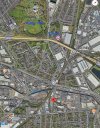M
mike-g
Guest
Is this pic any use

 Previous
Previous
Is that furthest left building Aston Hall?I think this must be the lost image being discussed on this thread. So would the building on the bridge have been a mill ? And what would the building be to the furthest left ? According to the earlier discussion, the farmer in the foreground is herding the animals down the later Holborn Hill.
View attachment 205037

